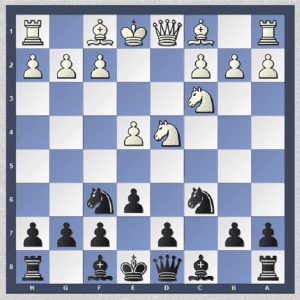1. Activity!
Together with the Shveshnikov and the “Kalashnikov”, the Four Knight Variation is the most active line for Black in the Sicilian. The pawn structure allows for energetic moves such as Bb4 and d7-d5. For that reason, many of White’s continuations, which would be good against other Sicilians tend to be quite harmless. 6.Be3, 6.Be2, and 6.Bc4 are met by 6..Bb4, while 6.g3 can be answered by 6..d5.
2. Easy to play
Since the Four Knights relies more on piece play than on pawn play and also more on concrete actions than on defense and counter-attack, it is much easier to handle compared to the Scheveningen-type Sicilians. For this reason, it is a good weapon for players with no or not too much experience in the Sicilian. Of course, this doesn’t exclude full-fledged Sicilian experts from the circle of potential users.
3. Critical lines come rarely
There are only two critical lines against the Four Knights: 6.Nxc6 and 6.Ndb5. While 6.Nxc6 is critical in the sense, that it can lead to sharp play, where both sides better know some bits of theory, it doesn’t question the soundness of the our line. Hence, 6.Ndb5 is to be considered the only critical test.
The good news for the Four Knights adept is, that on a level of Elo 2200 and below, all the non-critical lines are seen far more often than 6.Ndb5 or 6.Nxc6. And if you meet 6.Nxc6, the likelihood of a subprime follow-up such as 6..bxc6 7.Bd3? or 7.e5 Nd5 8.Nxd5? is very high.
4. Not well known
Compared to other Sicilians, the Four Knights is more or less a rare bird. The reason for this is that it is traditionally applied by only two groups of players: The Shveshnikov adepts, who, after 6.Ndb5, continue with 6..d6 7.Bf4 e5 and the hard-core Four Knights players who follow-up with 6..Bb4.
The Shveshikov group is reduces by the fact that many players use the direct move order 1.e4 c5 2.Nf3 Nc6 3.d4 cxd4 4.Nxd4 Nf6 5.Nc3 e5, thus circumventing the Four Knights.
The hard-core Four Knights fraction, on the other hand, is not too big, taking into account that after 6..Bb4 7.a3 Bxc3 8.Nxc3 d5 9.exd5 exd5 10.0-0 Black is deprived of his two bishops and has to look on an isolated pawn in his camp. While this position surely is playable due to good piece activity, it is not to everyone’s taste and objectively to be considered as slightly better for White.
The good news for the Four Knight player is, that all these facts make the Four Knights a rarely played sideline compared to the Najdorf, the Taimanov or other high calibre variations. Since your opponent doesn’t meet the FK regularly, chances are that he will be badly prepared.
5. My special variation to revive the Four Knights
The astute reader might ask himself now: Well, I don’t want to learn the Shveshnikov and I agree that the positions arising from 6.Ndb5 Bb4 are not the most appealing ones. So, what do I do with all this information? My answer is: Play 6.Ndb5 Bc5!
The move 6..Bc5 is not new and has been around for quite a while. However, on the basis of the games played so far, it didn’t prove satisfactory. I analyzed the complete body of this line and came up with many important improvements. My verdict is, that it is fully playable and gives good chances for equality.
Hence, even if the critical line 6.Ndb5 appears on the board, you have nothing to fear. More often than not, your opponent will be caught by surprise after 6..Bc5. He will fall into deep thinking and consume quite some time, which automatically leaves you with the psychological initiative. You will be the one kibitzing at the other games or pleasurably leaning backwards in your chair, legs crossed. Maybe, he won’t be able to solve the problems of the position and you will even end up with a slight advantage, which would be a very good result with Black.
6. My Four Knights course
Right now, I am conducting three opening courses with my students. One is about the English Opening, one is about the Bogo-Indian and the third one is about the Four Knights. Such courses are a good opportunity for the in-depth study of an opening, instead of merely scratching the surface. Apart from high quality analyses, you are provided with background knowledge with regard to typical structures, strategic concepts, typical manoeuvres and other patterns.

